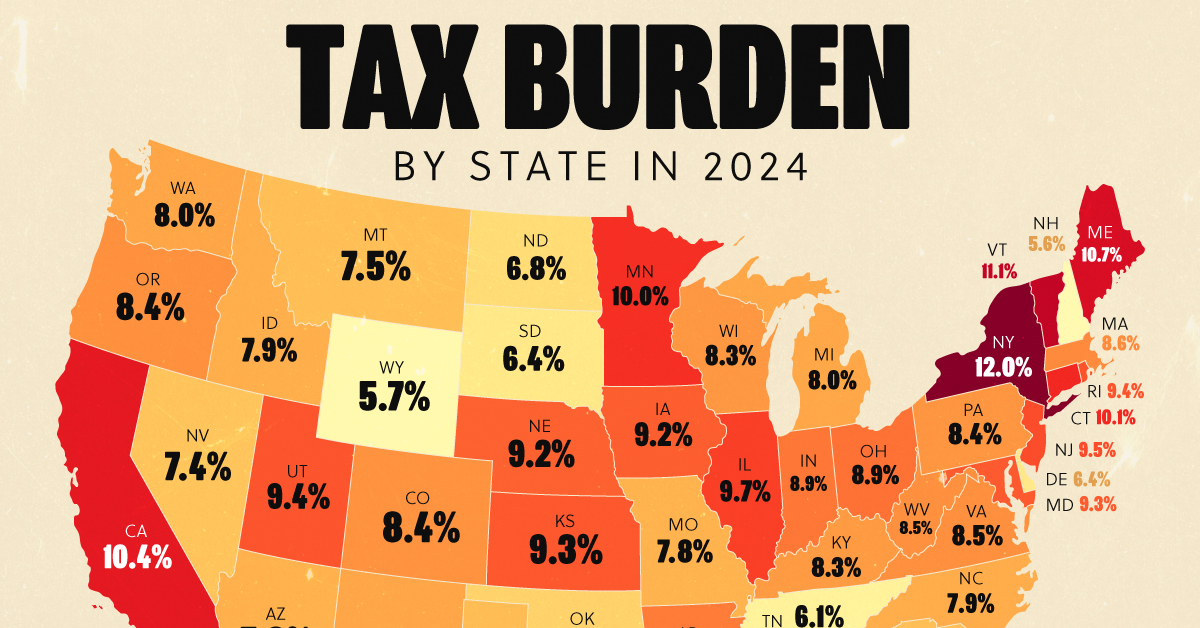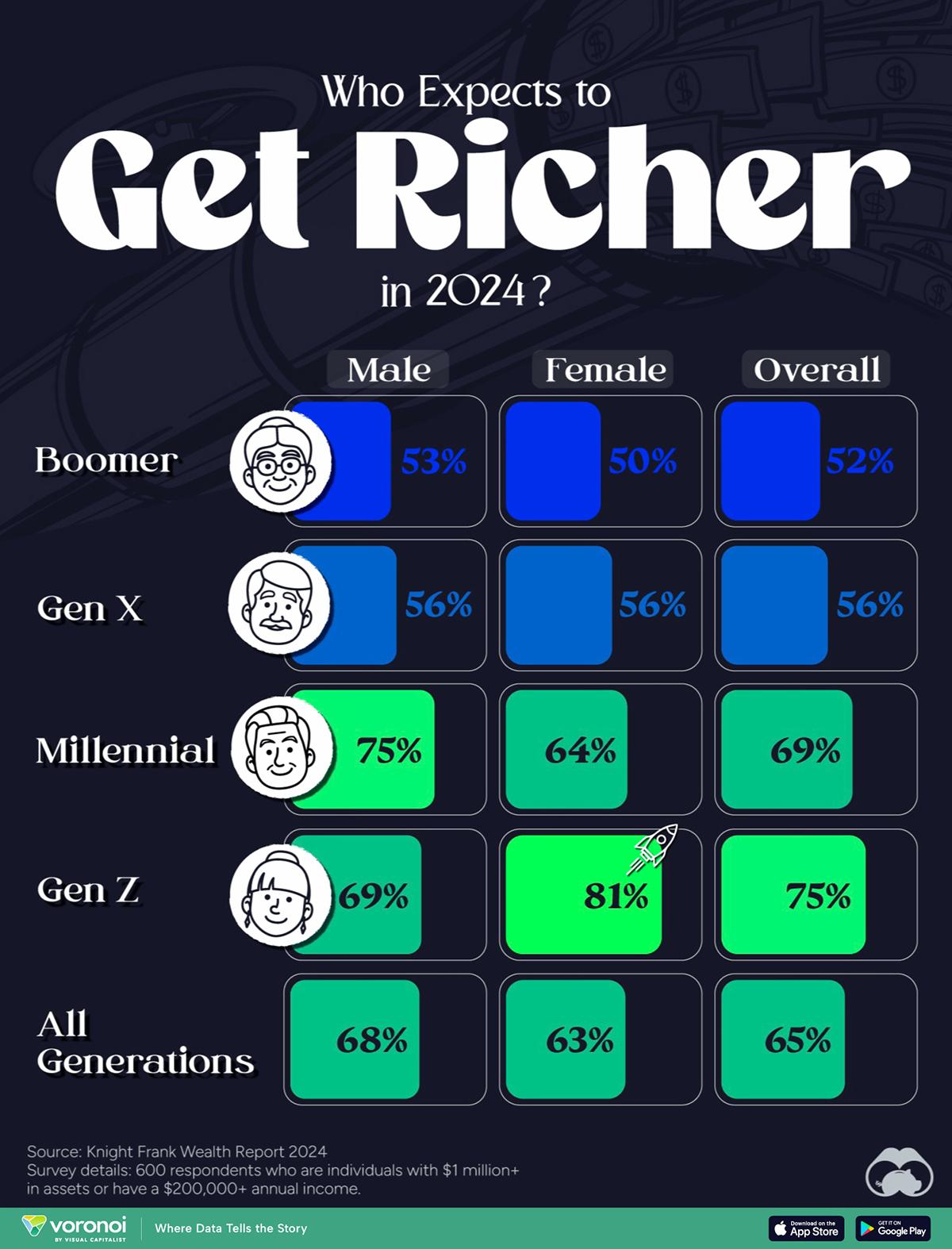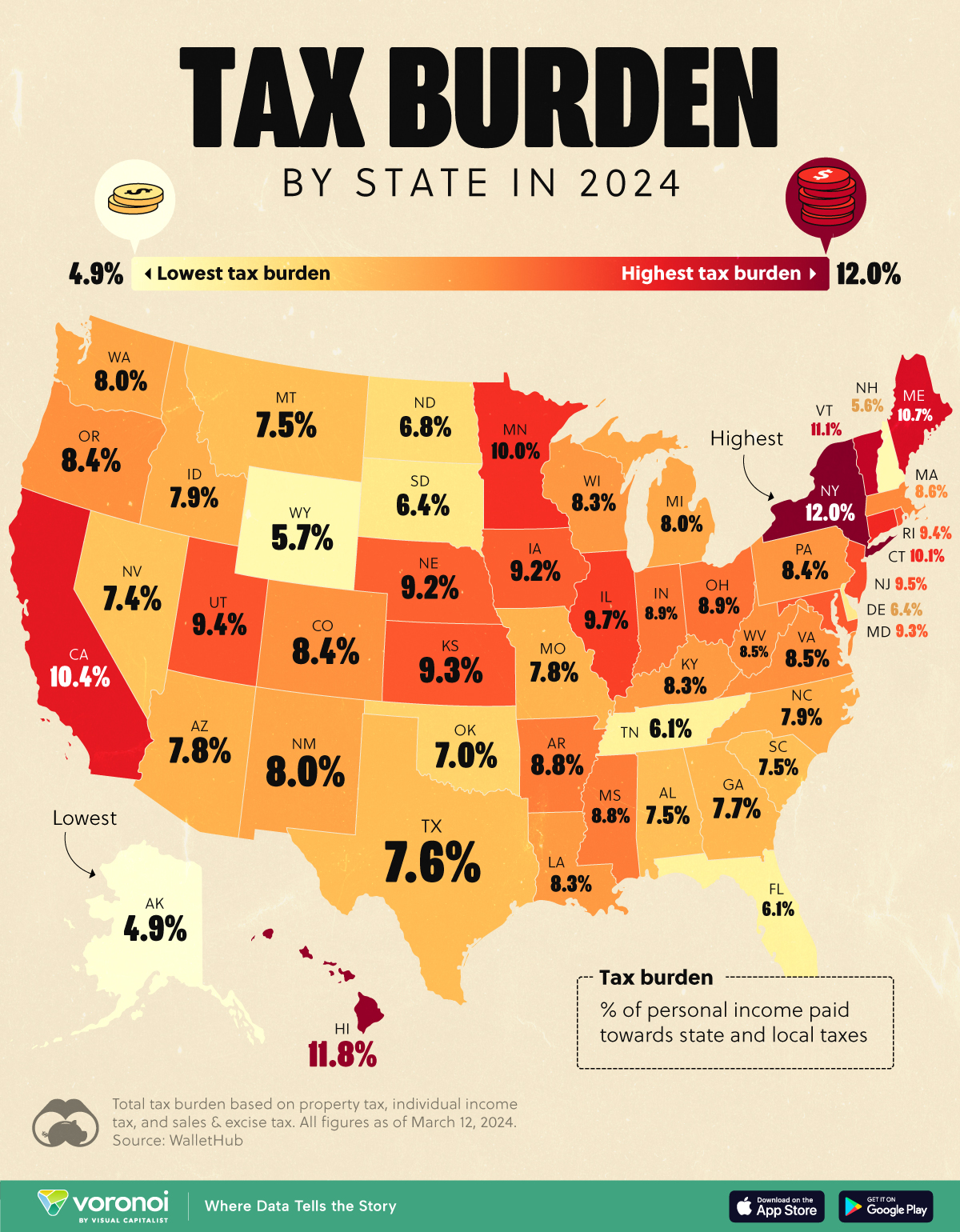Money
Who Expects to Get Richer in 2024, by Both Generation and Gender
![]() See this visualization first on the Voronoi app.
See this visualization first on the Voronoi app.
Who Expects to Get Richer in 2024, by Generation and Gender
This was originally posted on our Voronoi app. Download the app for free on Apple or Android and discover incredible data-driven charts from a variety of trusted sources.
The jury is still out on how the global economy is expected to perform in 2024, but as seen during the pandemic, economic turmoil sometimes provides opportunities for the wealthy.
We visualize the percentage of high net worth individual (HNWI) respondents who expect their wealth to increase in 2024, categorized by generation and gender, from the Knight Frank Next Gen Survey, accessible in their latest wealth report.
The survey covered 600 global HNWIs, who are individuals with more than $1 million in assets or make more than $200,000 a year, and then categorized their responses by gender and generation.
Affluent Gen Z Women Eye Financial Gains in 2024
At a glance, there’s a very apparent generational difference in the expectations of getting richer in 2024.
About half (52%) of the surveyed Baby Boomers think their assets will grow, compared to Gen X (56%), Millennials, (69%), and Gen Z (75%).
| Group | Male | Female | Overall |
|---|---|---|---|
| 👴 Boomer | 53% | 50% | 52% |
| 👩🦳 Gen X | 56% | 56% | 56% |
| 👩🦱 Millennial | 75% | 64% | 69% |
| 🧑🦰 Gen Z | 69% | 81% | 75% |
| 👨👩👧👦 All Generations | 68% | 63% | 65% |
Note: Percentage of respondents who said they expect their wealth will increase in 2024.
There’s also a noticeable gender difference. Men tend to be more optimistic than women, with one glaring exception.
A staggering 81% of the surveyed high net worth Gen Z women expect to make hay this year, making them the most optimistic of all the groups.
This corroborates a trend where Gen Z women were also the most optimistic in retirement planning. As CNBC reports, a combination of newer avenues of financial resources, and an openness towards advice, has given them a more optimistic attitude than their older counterparts.
Meanwhile, American Millennials are expected to become the richest generation ever as a $90 trillion asset transfer between Boomer parents and Millennial children begins to take place over the next two decades.
A huge percentage of that wealth comes in the form of property assets accumulated by generations before them. This especially includes houses, whose prices have skyrocketed over the last two decades.
Wealth
Visualizing the Tax Burden of Every U.S. State
Tax burden measures the percent of an individual’s income that is paid towards taxes. See where it’s the highest by state in this graphic.

Visualizing the Tax Burden of Every U.S. State
This was originally posted on our Voronoi app. Download the app for free on iOS or Android and discover incredible data-driven charts from a variety of trusted sources.
This map graphic visualizes the total tax burden in each U.S. state as of March 2024, based on figures compiled by WalletHub.
It’s important to understand that under this methodology, the tax burden measures the percent of an average person’s income that is paid towards state and local taxes. It considers property taxes, income taxes, and sales & excise tax.
Data and Methodology
The figures we used to create this graphic are listed in the table below.
| State | Total Tax Burden |
|---|---|
| New York | 12.0% |
| Hawaii | 11.8% |
| Vermont | 11.1% |
| Maine | 10.7% |
| California | 10.4% |
| Connecticut | 10.1% |
| Minnesota | 10.0% |
| Illinois | 9.7% |
| New Jersey | 9.5% |
| Rhode Island | 9.4% |
| Utah | 9.4% |
| Kansas | 9.3% |
| Maryland | 9.3% |
| Iowa | 9.2% |
| Nebraska | 9.2% |
| Ohio | 8.9% |
| Indiana | 8.9% |
| Arkansas | 8.8% |
| Mississippi | 8.8% |
| Massachusetts | 8.6% |
| Virginia | 8.5% |
| West Virginia | 8.5% |
| Oregon | 8.4% |
| Colorado | 8.4% |
| Pennsylvania | 8.4% |
| Wisconsin | 8.3% |
| Louisiana | 8.3% |
| Kentucky | 8.3% |
| Washington | 8.0% |
| New Mexico | 8.0% |
| Michigan | 8.0% |
| North Carolina | 7.9% |
| Idaho | 7.9% |
| Arizona | 7.8% |
| Missouri | 7.8% |
| Georgia | 7.7% |
| Texas | 7.6% |
| Alabama | 7.5% |
| Montana | 7.5% |
| South Carolina | 7.5% |
| Nevada | 7.4% |
| Oklahoma | 7.0% |
| North Dakota | 6.8% |
| South Dakota | 6.4% |
| Delaware | 6.4% |
| Tennessee | 6.1% |
| Florida | 6.1% |
| Wyoming | 5.7% |
| New Hampshire | 5.6% |
| Alaska | 4.9% |
From this data we can see that New York has the highest total tax burden. Residents in this state will pay, on average, 12% of their income to state and local governments.
Breaking this down into its three components, the average New Yorker pays 4.6% of their income on income taxes, 4.4% on property taxes, and 3% in sales & excise taxes.
At the other end of the spectrum, Alaska has the lowest tax burden of any state, equaling 4.9% of income. This is partly due to the fact that Alaskans do not pay state income tax.
Hate Paying Taxes?
In addition to Alaska, there are several other U.S. states that don’t charge income taxes. These are: Florida, Nevada, South Dakota, Tennessee, Texas, Washington, and Wyoming.
It’s also worth noting that New Hampshire does not have a regular income tax, but does charge a flat 4% on interest and dividend income according to the Tax Foundation.
Learn More About Taxation From Visual Capitalist
If you enjoyed this post, be sure to check out this graphic which ranks the countries with the lowest corporate tax rates, from 1980 to today.
-

 Markets5 days ago
Markets5 days agoVisualizing Global Inflation Forecasts (2024-2026)
-

 Green2 weeks ago
Green2 weeks agoThe Carbon Footprint of Major Travel Methods
-

 United States2 weeks ago
United States2 weeks agoVisualizing the Most Common Pets in the U.S.
-

 Culture2 weeks ago
Culture2 weeks agoThe World’s Top Media Franchises by All-Time Revenue
-

 voronoi1 week ago
voronoi1 week agoBest Visualizations of April on the Voronoi App
-

 Wealth1 week ago
Wealth1 week agoCharted: Which Country Has the Most Billionaires in 2024?
-

 Markets1 week ago
Markets1 week agoThe Top Private Equity Firms by Country
-

 Markets1 week ago
Markets1 week agoThe Best U.S. Companies to Work for According to LinkedIn













